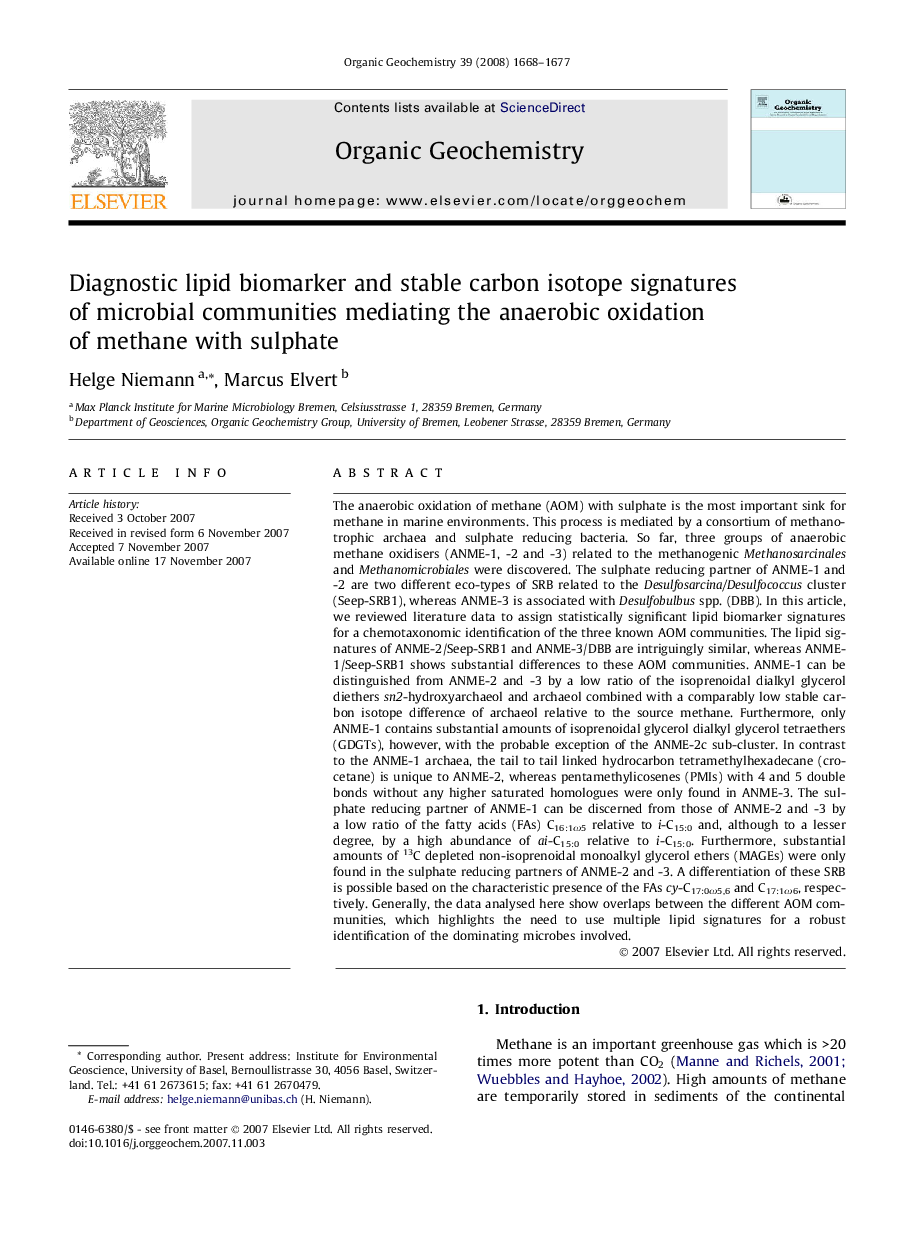| کد مقاله | کد نشریه | سال انتشار | مقاله انگلیسی | نسخه تمام متن |
|---|---|---|---|---|
| 5162877 | 1379758 | 2008 | 10 صفحه PDF | دانلود رایگان |
عنوان انگلیسی مقاله ISI
Diagnostic lipid biomarker and stable carbon isotope signatures of microbial communities mediating the anaerobic oxidation of methane with sulphate
دانلود مقاله + سفارش ترجمه
دانلود مقاله ISI انگلیسی
رایگان برای ایرانیان
موضوعات مرتبط
مهندسی و علوم پایه
شیمی
شیمی آلی
پیش نمایش صفحه اول مقاله

چکیده انگلیسی
The anaerobic oxidation of methane (AOM) with sulphate is the most important sink for methane in marine environments. This process is mediated by a consortium of methanotrophic archaea and sulphate reducing bacteria. So far, three groups of anaerobic methane oxidisers (ANME-1, -2 and -3) related to the methanogenic Methanosarcinales and Methanomicrobiales were discovered. The sulphate reducing partner of ANME-1 and -2 are two different eco-types of SRB related to the Desulfosarcina/Desulfococcus cluster (Seep-SRB1), whereas ANME-3 is associated with Desulfobulbus spp. (DBB). In this article, we reviewed literature data to assign statistically significant lipid biomarker signatures for a chemotaxonomic identification of the three known AOM communities. The lipid signatures of ANME-2/Seep-SRB1 and ANME-3/DBB are intriguingly similar, whereas ANME-1/Seep-SRB1 shows substantial differences to these AOM communities. ANME-1 can be distinguished from ANME-2 and -3 by a low ratio of the isoprenoidal dialkyl glycerol diethers sn2-hydroxyarchaeol and archaeol combined with a comparably low stable carbon isotope difference of archaeol relative to the source methane. Furthermore, only ANME-1 contains substantial amounts of isoprenoidal glycerol dialkyl glycerol tetraethers (GDGTs), however, with the probable exception of the ANME-2c sub-cluster. In contrast to the ANME-1 archaea, the tail to tail linked hydrocarbon tetramethylhexadecane (crocetane) is unique to ANME-2, whereas pentamethylicosenes (PMIs) with 4 and 5 double bonds without any higher saturated homologues were only found in ANME-3. The sulphate reducing partner of ANME-1 can be discerned from those of ANME-2 and -3 by a low ratio of the fatty acids (FAs) C16:1Ï5 relative to i-C15:0 and, although to a lesser degree, by a high abundance of ai-C15:0 relative to i-C15:0. Furthermore, substantial amounts of 13C depleted non-isoprenoidal monoalkyl glycerol ethers (MAGEs) were only found in the sulphate reducing partners of ANME-2 and -3. A differentiation of these SRB is possible based on the characteristic presence of the FAs cy-C17:0Ï5,6 and C17:1Ï6, respectively. Generally, the data analysed here show overlaps between the different AOM communities, which highlights the need to use multiple lipid signatures for a robust identification of the dominating microbes involved.
ناشر
Database: Elsevier - ScienceDirect (ساینس دایرکت)
Journal: Organic Geochemistry - Volume 39, Issue 12, December 2008, Pages 1668-1677
Journal: Organic Geochemistry - Volume 39, Issue 12, December 2008, Pages 1668-1677
نویسندگان
Helge Niemann, Marcus Elvert,